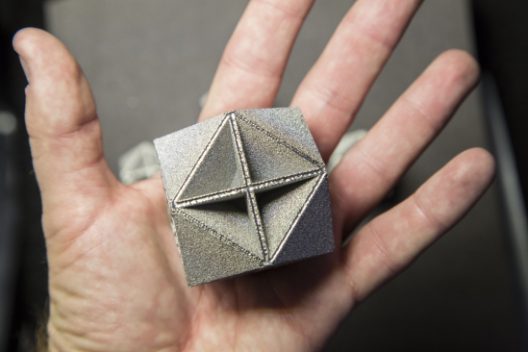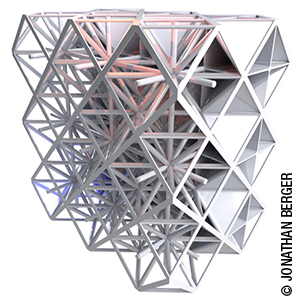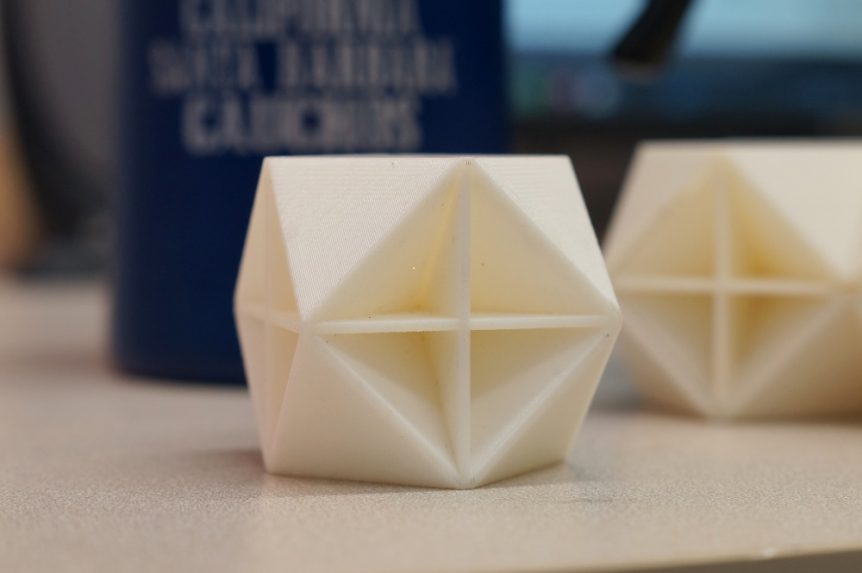Jonathan Berger has come up with a foam structure that will make it more than the ephemeral filling in composite construction sandwiches. Isomax™ foam could be the entire structure because of its unique geometry. He claims it to be the world’s first material to achieve structural performance predicted by theoretical bounds.

Isomax module exhibits highest possible strength, stiffness
His letter in the journal Nature describes the geometry Berger and his collaborators created to enable such lightness, strength, and versatility. Berger, a postdoctoral researcher at UCSB’s mechanical engineering department, worked with mechanical engineering professor Robert McMeeking and materials scientist Haydn N. G. Wadley from the University of Virginia to prove the ideas Berger first conceived in 2015.
This solid foam, “a combination of stiff substance and air pockets,” uses three-dimensional pyramid and cross cell geometry to achieve high stiffness. The ordered cells are set apart by walls forming three sides and a base, and as octahedra, reinforced inside a “cross” of intersecting diagonal walls. This “mostly air” structure is “maximally stiff” in all directions. It can resist distortion and collapse unlike other geometries that are strong in one or two directions, but not in all. Isomax can resist crushing and shearing despite its lightness.
Anxious to see his theories demonstrated, Berger realized peer review was necessary. “There was obviously a lot of positive feedback, but for me as a scientist, it’s a bit too much hand waving until you have something in a peer-reviewed journal.”
McMeeking gave the theory mathematical backup. “I carried out some simplified calculations of the stiffnesses of some of the foams and was able to see that the pencil-and-paper results agreed with the computer calculations. This gave us confidence that the computer calculations were both correct and being formulated accurately.” They also demonstrated that the researchers had obtained, “Optimal geometries for the heavier weight foams.”

Combining pyramids and crosses, Isomax is capable of creating structures of all shapes and sizes. Illustration: Johnathan Berger
Wadley noted that Isomax, “Is going to be a very interesting metamaterial. It will also be an excellent thermal insulating and sound absorbing material. Potential applications for this ultralight material are likely to emerge in aerospace structures, for lightweighting automobiles and in many robotic machines, especially mobile types that carry their own power and must maneuver.” The design is compatible with various manufacturing methods, “From origami-like folding to bonding and 3-D printing.
Lighter and far stronger than balsa wood (used in early fiberglass sailplanes as a sandwich core), Isomax has potential for sporting goods, prosthetics, and far larger structures. Inspired by his love of “gravity-related sports” such as skiing and mountain biking, Berger is happy to see the new material’s potential use in such applications. He sees multiple possibilities and has started a company, NAMA Development, to further its use.
Read more about Isomax in, “Mechanical metamaterials at the theoretical limit of isotropic elastic stiffness: in Nature (published online on February 20, 2017).
Thanks to Colin Rush for pointing your editor to this breakthrough. By the way, this is the 1,000th entry by this editor to this blog since its inception.

